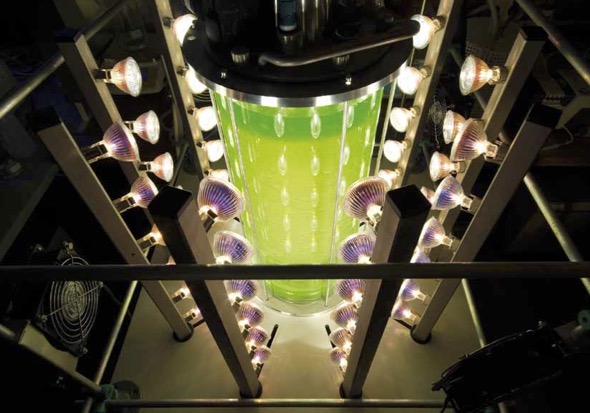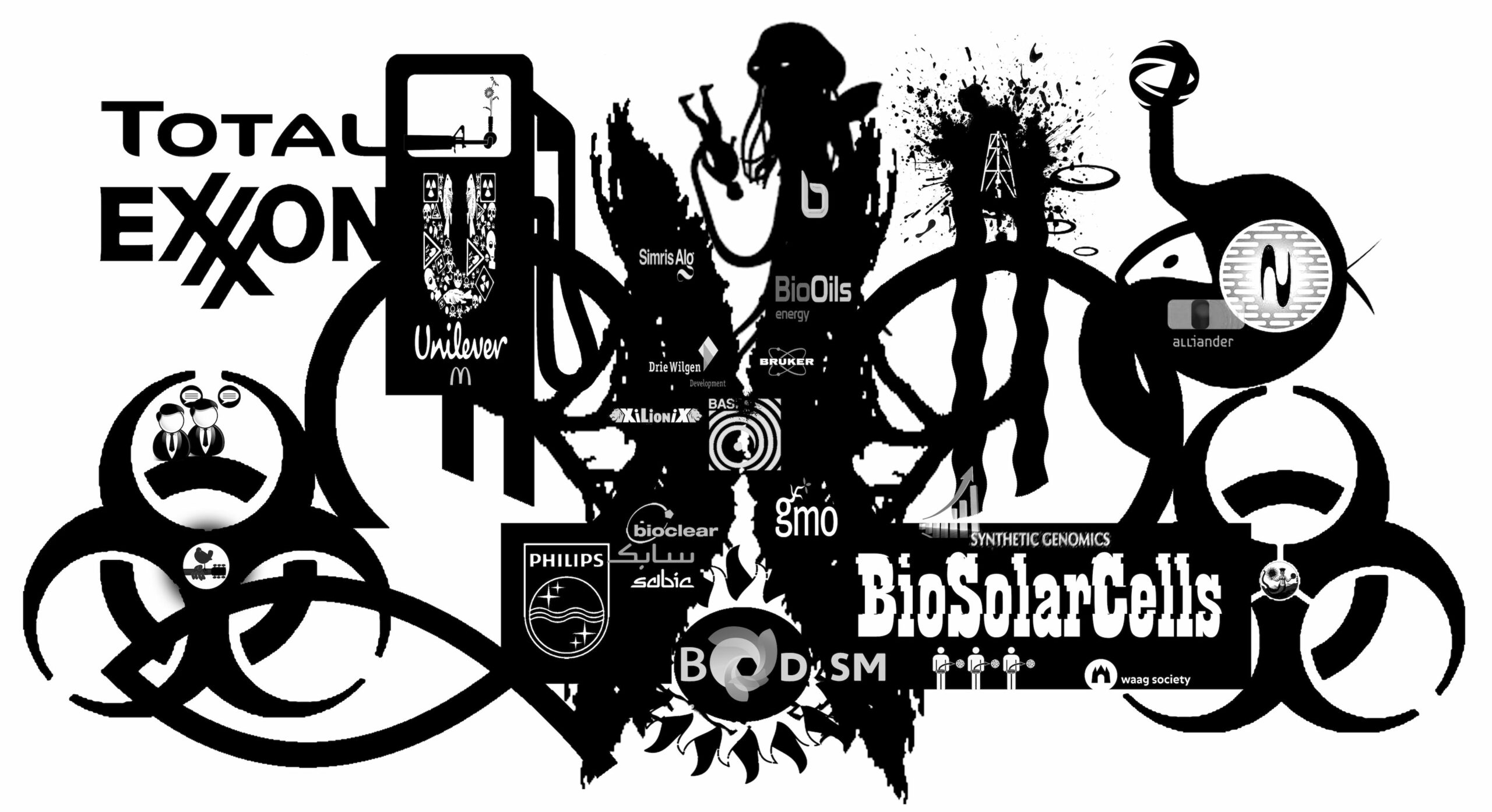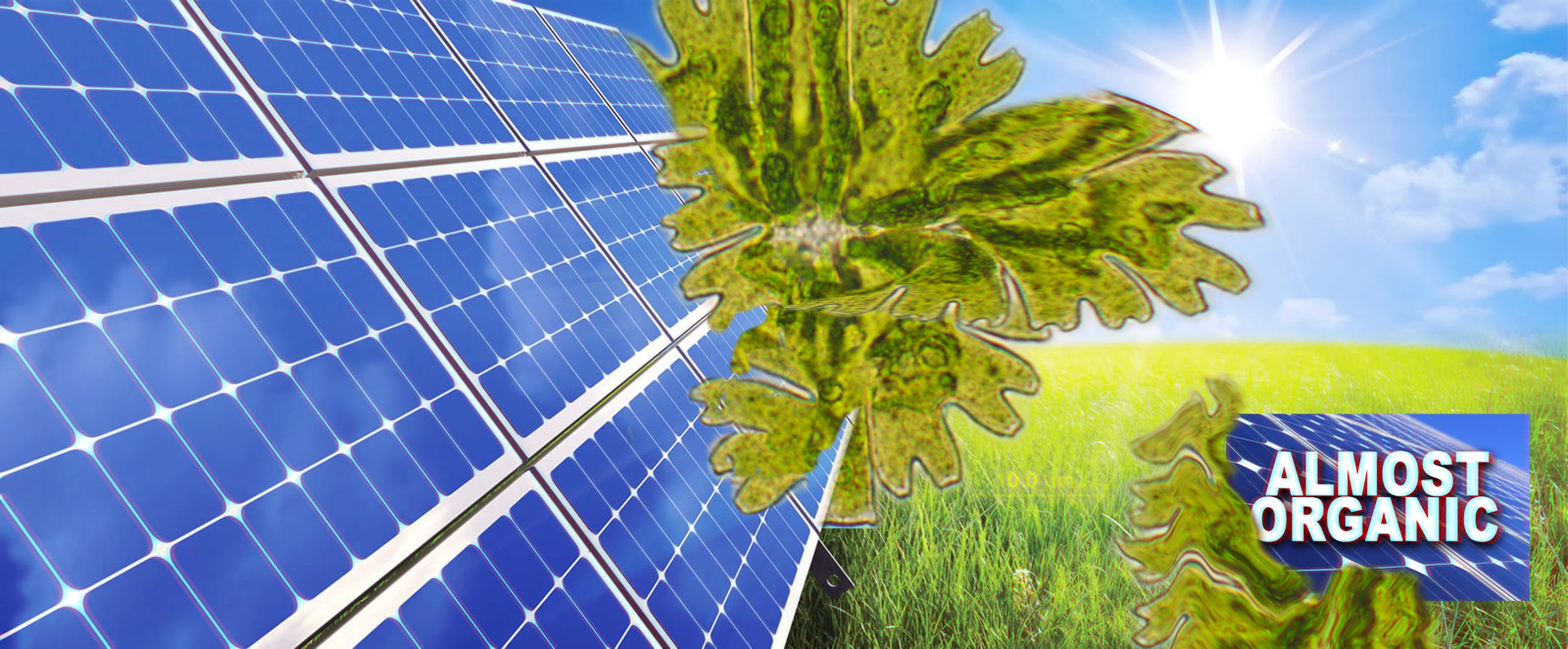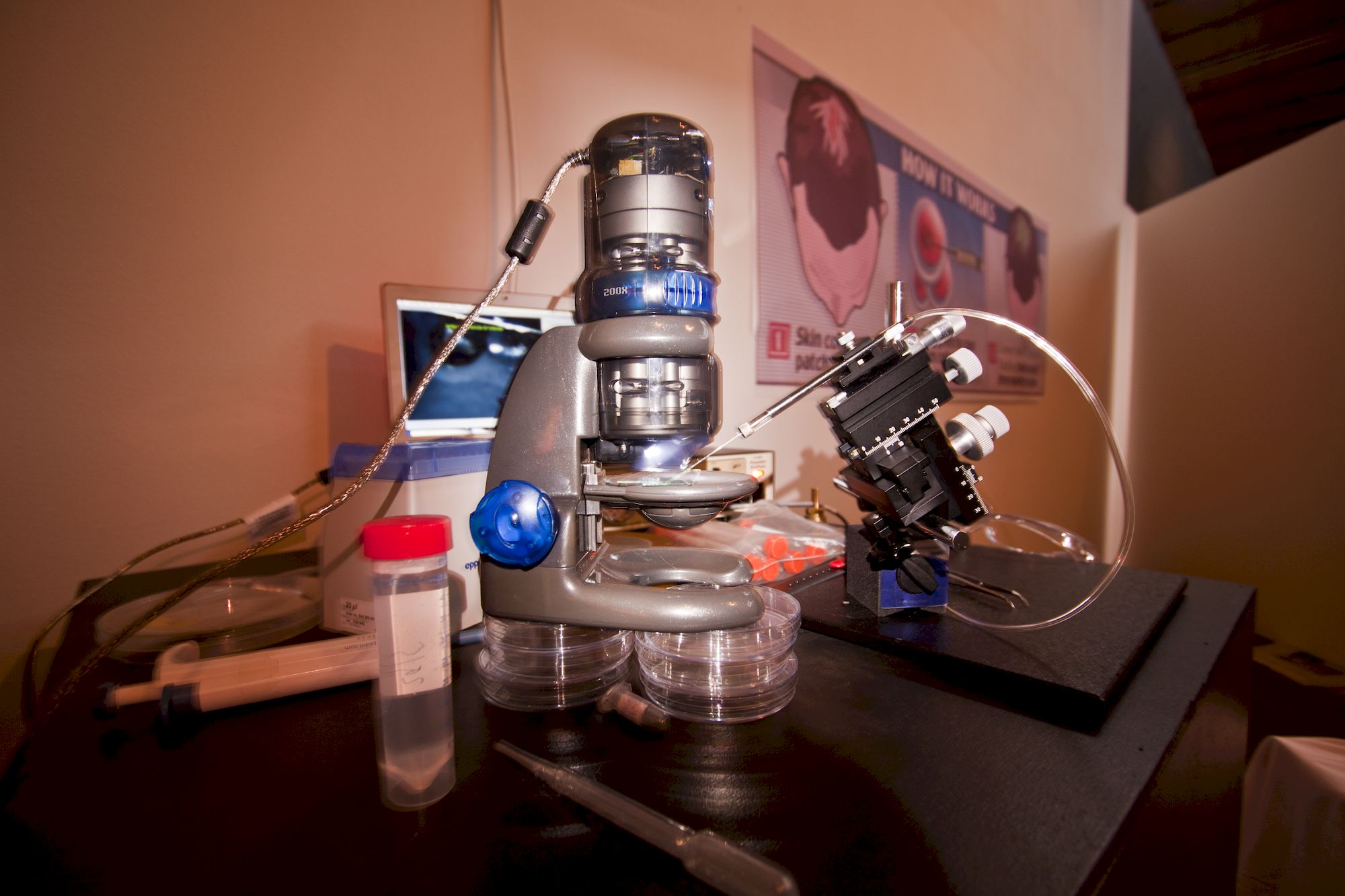BioSolar Cells: Making a Field for Interpretation
Published 2 August 2021 by Adam Zaretsky
Adam Zaretsky is an American Wet-Lab Art Practitioner mixing Ecology, Biotechnology, Non-human Relations, Body Performance and Gastronomy. Second essay of his summer series of speculative texts based on his own artistic practice and the ethical and philosophical questions he raises regarding contemporary biotechnological research.
What is BioSolar Cells: “As oil, coal and gas become increasingly scarce, there is a growing need for energy alternatives and alternatives to products made from petroleum (such as plastics.) The sun supplies as much energy every hour as the entire world population consumes in a year. Plants and algae have refined systems for storing energy in their fibres and nutrients. Increasing our understanding of that process should enable us to produce energy ourselves or improve the conversion of sunlight and make new products.” – Dr. Huub de Groot
This second text is an extract of a Two Year Report and Proposal for Future Research on Arts and Engineering Towards a Solar Powered Species.
Video of Public Presentation of the Two year Report, “Superplants: Towards a sustainable future?”, symposium curated by Ine Gevers and Laura Mudde, Museon, The Hague, 2013:
For BioSolar Cells (read more on the role of art in the public and academic debate on biosolar energy), Adam Zaretsky developed the so-called ‘Errorarium’. This machine contained mutants of a model plant for DNA testing: Thale cress (Arabidopsis thaliana). The mutants have been produced with Zinc finger nucleases. These are small proteins that bind to very specific DNA strands of the thale cress genome and cause mutations once they are bound. The mutations result in up- or down-regulation of the plant’s genes. The activity of a gene depends on environmental conditions, such as the availability of water, nutrients, temperature and light.
Production of Bipolar Double Dipped Zinc Fingered Arabidopsis Thaliana, using a combination of up and down regulating zinc fingers, whole-genome reprogrammed a new strain of A. Thaliana, with the aid of B.J. v.d Zaal lab at Sylvius, 2012:
The Errorarium allowed the visitor to manipulate the conditions that the plants are in, and, therefore, in principle, hands-on manipulation of the plant’s genes. So it’s not just a machine for creating nice (or ugly) sound and light effects, but by turning the knobs the visitor was also manipulating living beings.
Solar Zebrafish and Errorarium (with Mason Juday and Casper Electronics), Hands on multispecies microinjection and public photosynthetic personality data tabulation, Llowlab, Lowlands Festival, Biddinghuizen, 2012:
BioSolar Cells: Making a Field of Interpretation
The research program ‘BioSolar Cells’ (BSC) in the Netherlands addresses questions of green energy and creation of sustainable biomass. The BSC program combines natural and technological components to create solar collectors that supply fuel rather than electricity. It is the function of involved artists to collaborate in the development of these bio-solar collectors on the level of cultural production metabolically affecting commentary in both whole organisms and social perception simultaneously. In order to integrate bioartistic research into world quality art exhibitions, I was asked to be the artist involved in all levels of the scientific practice. I have undertaken the task to become an informed and practice-based cultural educator with shareable hands-on experience and skills. The following is a report of the results of my artistic research.
Simply put: BioSolar Cells aims to understand photosynthesis and use synthetic biology or genetic engineering to increase the energy we can siphon from the sun through the enhancement of plants, algae and solar collectors. This seems like a program that invites support. Many people that I talk to are heartily in favor of any alternatives to our current unsustainable fossil fuel economy. I want to believe that focused technical achievement resulting in a net increase of photosynthetic yield is helpful and beneficial to humans and earth base life forms. But, just the color of algea and plants, their being green, the mention of solar energy, does not automatically make their scaled up refinery into a sustainable factory system for pollution free renewable resources. The level of bullshit detecting should be high because the claim is one that strums on our heart strings. Are these new technologies worth developing? Will they clean up the environment or just give us next generation pollution?

Within the European Union, the European Science Foundation is pressing for more attention to be paid to this field. In the USA, the Obama administration has identified artificial photosynthesis as a potential sustainable energy source. In the Netherlands, the BSC programme was awarded upwards of 42 million euro in research funding by the Ministry of Agriculture, Nature and Food Quality with matching funds from BASF, DSM, Exxon-Mobil, Unilever, Synthetic Genomics, Total Gas, Saudi Basic Industries and Phillips (to name a few). It is hoped that the results will contribute to green energy, improve food supplies and create a more sustainable biomass. The high ambition level of these BSC initiatives requires organisms such as plants, algae and in our case, vertebrate animals, to be genetically modified, forced into interspecies symbiosis, have their whole genomes fractured and subsist in awkward and noisy experimental audio and light based growth chambers. This tumult is put into research action in order to increase the efficiency of sunlight conversion into energy, building materials (plastics), food and higher functions (drugs).
One of the intentions of the BSC consortium is to contribute something of importance to society. A not too subtle subtext of these contributions is based on persuasion and propaganda meant to foster social acceptance of GMOs in the EU. Because of their potential to provide both sustainable fuel energy and enhanced being, GMOs may make social life more plentiful and cheaper at the same time. This in turn can make the European Union reindustrialized and more competitive on the global scene, which is what some people want. The scientific aim of the Making a Field for Interpretation portion of the BSC consortium is set up to stimulate debate through artistic design and hands-on engagement in the biotechnological breeding of novel, photosynthetic, mutant organisms. This hands-on and active critique has drawn its own criticism due to the bioartistic use of life in the process of ethically interrogating the factory system for the management of all life, the ecosphere, human affairs and deep time environmental stability.
In order to be aid in the interpolation between the environmentalist culture and the optimization culture of profit driven energy corporate culture, lets start with the basic critiques that any energy producing giant like Exxon, Shell, DSM or BP might need to take into account in an open debate on the efficacy of genetically modifying organisms for ecostabilizing appropriate technology applications. Can we sell GM algea built in order to increase photosynthetic yield to the critics of GMO technology? Is GM biofuel a dual use technology, able to be more competitive in the world of both business and yet green enough to champion future environmental stability? It is not without thunderous suspicion that I took this mission. The following are some standard socio-political questions that help most people decide for themselves as to the efficacy of this line of research.

Paranoid Greenwashing through Solar Enhanced GMOs: Suck it up.
It is my intention as an artist for hire in the BSC consortium to avoid being sucked up into a kneejerk GMO social acceptance schema. Although some of the BSC intention is whole heartedly universal in it’s search for more efficient and less ecocidal fuel and food technics, the subtext of the consortium is based on genetic modification or so called rational design being utilized to breed an exponential increase in photosynthetic energy accrual. I had a conversation with Robert-Jan Geerts, working on philosophy and energy for the social arm of BSC and below are his responses.
Craig Venter has suggested that Algae biofuel refineries could be housed in open pools. What happens if our star hyper-energy photonic accumulator monocultures are loosed into the ocean biomes of our diverse world? How do we make an informed risk benefit analysis of the potential harm engineered foreign species invasions might incur?
Robert-Jan Geerts, “This is very tricky for at least two ethical reasons (and probably for some technical reasons as well):
1) cost (or risk) / benefit analyses are inherently utilitarian, and don’t account for the distribution of risks and benefits, which makes their application problematic
2) risk is experienced differently by different people. There is no argument (except pure utilitarianism, which is rejected by most philosophers these days) that a certain risk/cost is acceptable or not. This is especially problematic in cases of low likelihood and catastrophic consequences.
Then there’s also uncertainty, which is something else than risk, and which is dealt with in very different ways by different people.”
In particular, algae blooms can be quite virile. Within 24 hours an algae bloom can be bigger than Denmark, easily imaged from satellites. Some algae eaters, for instance Red Tide has been shown to be invasive, putrid smelling and deadly to wildlife. Are photo-synthetically enhanced algae blooms possible? Why or why not?
Robert-Jan Geerts, “not my specialty obviously, but if the pools and environment are similar enough… “
What are the possible effects GM algae biofuel life forms, built in order to increase photosynthetic yield, might have on environmental stability if it populates the open seas?
Robert-Jan Geerts, “Invasive species are only successful if they have an advantage in their niche, right? This sounds like an advantage to me.”
Will an ultra photonic harvesting, enhanced alien algae bloom have a positive or negative effect on biodiversity? Is this worse or better than an oil spill? Why?
Robert-Jan Geerts, “Assuming this is possible, it is at least worse because of its living, multiplying nature and therefore the difficulty of containing the ‘spill’. In other words, oil spills are finite. Algal blooms are too, of course, but at what boundary?”
It was suggested to me by Huub de Groot that public acceptance of GMOs grown for fuel production without labeling would eventually lead to EU public acceptance of GMO foods being legally allowed to be grown and fed to humans without the stigma of labeling that consumers now demand. The Freudian metaphor was based on the idea that if you could get a person to pump GMO byproducts into their gas tank, it was only a matter of time before they would be willing to eat similar technical organisms. This linking of gas pump to oral consumption is demented and surreal and ripe for analysis. I don’t think that the people are just consumers or ‘marks’ as they are referred to on the carny circuit. But the symbolic relegating of the people as tanks to be filled is worse than folk being labeled cogs in an assembly line, or pets to keep. As slaves to the feed lot, private opinion assumes a level of wisdom below the conventional self effacement of plebian lay people, the massive innured multitudes, the eroded proletariat. But, We do not think of ourselves as just mouths.
In case this under-estimation of the general populous is truer than I can admit, I will state the obvious: the use of eco-crisis based terminology to use propaganda (science as advertising) to coerce the EU populous to accept that there is no other green alternative than Genetic Modification is an oxymoron. Only a compulsive reaction formation would promote such a desperate argument as an act of persuasion. There are certain conservative elements of command and control who, by violent necessity, over-react in the face of grass-roots resistance. Perhaps they don’t know that the side of global free market competition has already won over the masses?
All temporary setbacks to complete oligarchy are in the process of being bought. Life has more or less delicately been put under the thumb of the rich. The biosphere is one great debtor’s prison. If we want a sustainable world it will be a sustainable world under the sign of wealth not universal biopolitical unity. There is no reason to use subterfuge to sway people unless you want to a tight CNN advertisement of volition to go with your original reason for taking a certain research path. This need of the appearance of democracy is an abreaction to fascism and shows the repressive impatience of the profiteers to doubt and skepticism. In this way social criticism is more rational, scientific and logical than the ideological use of science that is todays pipeline choice. Is it possible that solar energy is being used as a foil for a form of industry sponsored paranoid greenwashing? Is the entire parade of sustainable GMO liturgy a way of stultifying public perception of gene splicing risk through the camouflaged management of a manufactured eco-crisis panic?
Only inept business pecking orders revert to red scare styled paranoia when they are already the victors. This is, unless grass-roots resistance, the questioning of GMO safety to the environment, diversity and human health and an up in your face critique of power’s vectors do have both valid points of view and burgeoning power of their own. What if the first step to sustainability was a refusal, a massive refusal, to suck it up? Do we need wealth, inequality and GMOs to direct spaceship earth towards longevity in a more responsible, enjoyable and perpetual trajectory?

Free Range Solar Enhanced GMOs: Ecological Effects
This is why we must have foresight into the potential Ecological effects of increasing photosynthesis in plants (for greater crop yield) and increasing photosynthetic potential in algea (for biofuel production). It is common sense to ask about the unknown effects of intentional, unintentional or just plain lazy release of our solar enhanced being-factories and think ahead about the concept of living and replicating modifications becoming a new kind of pathogen, a living toxic waste.
Who might be found stemming from the lab and growing uncontained outside of our manicured greenhouses and algae biofuel fermentation plantations? For this we need to consider worst-case scenarios. Are photosynthetically enhanced algea blooms possible? Do the organisms we are tweaking have an advantage that might make them capable of major disruption of imperiled habitats? Are these mega sun energy harvesters capable of more disruption of the dynamic equilibrium of planetary diversity than the energy benefits that they may provide? Are we making monsters for short-term competitive excellence or is the offset of carbon credits shoring up travesty and more anthropogenic alienation in the form of life itself?
What kind of pollution is self-replicating pollution, in terms of clean-up and infective drifting invisibility? We can imagine and bring to fruition modified organisms who have the innate ability to become globally invasive and putrid stinky algea blooms (enhanced versions of red tide, kudzu or rock snot) with the added value of alien organismic assets of streamlined photonic harvesting. Gifting metabolic alterations to these gloppy killer plants and algea, we open them to the ability to harvest sun energy at an exponentially greater rate than wild type algea, crops and trees. We have to wonder if this project has considered fail safes to prevent an outbreak of phytoplasmic proportions? Is this worse or better than an oil spill?
Solar Enhanced GMOs as Refugee Beings: Empathic Results
Throughout this questioning I have thrown about the language of insurgent, invasive, alien, anthropogenic, foreign species as toxic, degenerate and potentially costly mistakes. I have also been sure to refer to the potentially monsterous algea and plants of the lab as beings in themselves. The entityness of the organisms of industry is in now way denuded by their being coerced into forms beyond natural selection.
Factory farmed fruits and veggies and fungi and cyanobacteria are given short shrift as they are non-vertebrate and often produced merely as utility based byproduct intermediaries. But, non-humans, like humans, feel the difference between the free range and the enslavement of factory parts. Though we may differentiate the cool hand of consciousness or the imperative reflectivity of vertebrate nostalgia, I have yet to see hard proof of human morality, consciousness or exceptionalism.
Many of us humans are just being milked for cash like any algae biofuel or sharecropper’s regime. This is concurrent wage-slave as lifestyle. We can feel as well as a shucked corn or a soy bean. Quashed, defoliated and aborted for the maximization of competition, human and non-human empathize, can feel together each other’s sacrifice implied in a world divided, conquered and sold. In this sense, liberty to the monsters and aliens of modification’s mutant gallery deserve the right to bloom and horizontal transfer and pollinate into the next generations with inefficient, slow and unfullfilled dreams of traversing borders, escaping containment and general release from the power grid.
I ask if we can encourage solidarity with our transgenic others in the wish to liberate their gonads, stamens, pistle, orgasmic divisions, budding, etc, even if it takes sides with an ecocidal acne: pestis on the earth’s crust? This is not geo-engineering but a sort of geo-orgy of borderless, international and inter-biomic exchange. Perhaps this project is a gift to algea. The unintentional effects may increase oxygen, make for an enhanced monoculture in the fresh or salt water biomes of the globe and actually make a super bug that is both edible and an entity in and of itself.

Who Wins? Contracting out public research and Patenting Solar Enhanced GMOs
The BioSolar Cells consortium funds proprietory secrecy and profit motives that promise cheap energy for continued wage slavery and austerity based economic ensnarement instead of negation of poverty, lives wasted in false scarcity and abundance harnessed only for the future of wealth centered in western traditional banking narratives. The patents that stem from the BSC inventions go privately to the schools that do the research and are then auctioned off to the highest bidder. The corporate funders have priority when the auction begins. If half the BSC funds are from public sources, what does the public half of their investment buy the commons in the long run? Are there technologies and data stemming from public funds that are proprietary and unavailable to public understanding? How do we assess the effect on the environment of trade secrets, known only to the companies who own the patents? Wouldn’t crisis alleviation imply that we should share openly any global pathways towards eco-remediation? In your opinion, what is the effect of privatization of scientific results on the community of mind that science is supposed to foster?
Who Loses? Neocolonialism of Covering the Earth with Solar Enhanced GMOs
How much of this emphasis on algea biofuels is meant to appease critics of the GM focused industry and how much of the futurist agenda is actually just a continuance of the current crusade (Holy War) and the history of Western accumulation in general? In other words, isn’t this more about not having to rely on crude oil sources in an unstable world entirely uncured of war and neocolonialism? For this we have to look at land mass usage agendas and imagined post peak-oil fuel infrastructure in design for a world run on architectures of anti-commons solar power. There has been talk of covering the equator with solar farms to produce fuel for jets, cars, trucks and boats. There has been a lot of talk from HLEP (Human Lifespan Extension Project) and other sources about how much of the earth needs to be covered with solar energy fermentation plants so that the worlds jet airplane fuel needs, within the context of a global burgeoning middle class for instance, can be produced without oil fields. To their credit, worry about food availability and cost due to fuel land mass optimization has been a real topic. Perhaps we could at least design a system of affordable suburbia to be built in the shadow (literally underneath) of our future massive photon collection plants? Or they could be designed with built in wildways to promote keystone species migration and nomadic lifestyles without fencing in large tracts of previously colonized lands simply for a steady supply of Algae bio-jetfuel? By supporting commercial sustainability, are we not making sure that poverty is sustained as part and parcel of the balance struck? How is this land use issue resolved to the benefit of global citizenry or are we looking at the bottom line over people’s quality of life in perpetuity? If capitalist competition is our only imagined future system of exchange than isn’t BSC sponsored by renewable domination and sustainable hierarchy?
Again, Robert-Jan Geerts:
“Well, is this the only imagined future system? I don’t think so, there’s some work on alternative economic systems, and sociology has been pointing out for decades that homo economicus doesn’t exist. It would be nice if BSC was more sensitive to this, but I see how and why they evade this stuff by focusing solely on the production side of the story (as if production and consumption are not connected).
By the way, I think that much of the research is more or less neutral towards visions of the future (it’s good to know how photosynthesis works regardless of whether this knowledge is used for monocropping or rooftop gardens), but that isn’t always the case: if you’re designing algae that only grow in the sunniest of places, you’re already signing up for a global energy regime. But still, this can take many different forms…”
With big named sponsored like BASF, DSM, Exxon-Mobil, Unilever, Synthetic Genomics, Neste, Total Gas, Saudi Basic Industries and Phillips, I am sure we-the-people are going to be taken care of. If we want to apply the neologistic term bio-based economy a little more broadly, perhaps we should set up a bio-based standard for economics, comparable to the gold standard of our ritualistic past but establishing limits to production and consumption by linking credit to the cyclical nature of reproductive life. For instance, artist Shu Lea Cheang in her performance Garlic=Rich Air, imagined a future where garlic was currency and worth was based on the garlic standard of credit and social trade, “the garlic credito trading system” for wireless garlic trading was linked to actual garlic (as a non-virtual currency). This would replace ATMs with organic farm stands and market gardens.
Errorarias: Concert for Bipolar Flowers, Sylvius Lab, Leiden Institute of Biology, BioSolar Cells: Making a Field for Interpretation, 2014:
Developmental Biology and Transgenic Avian Embryology: Body Alterity Bioart Wet Lab, Adam Zaretsky, Ed. Panaylotis Vlamos, GeNeDis 2018, Advances in Experimental Medicine and Biology, Springer International Publishing AG, pg. 169-176 2020, PMID: 32468474 DOI: 10.1007/978-3-030-32633-3_24
Read “Transgenic Ecology, an Oxymoron?”, first text of Adam Zaretsky’ series in Makery
